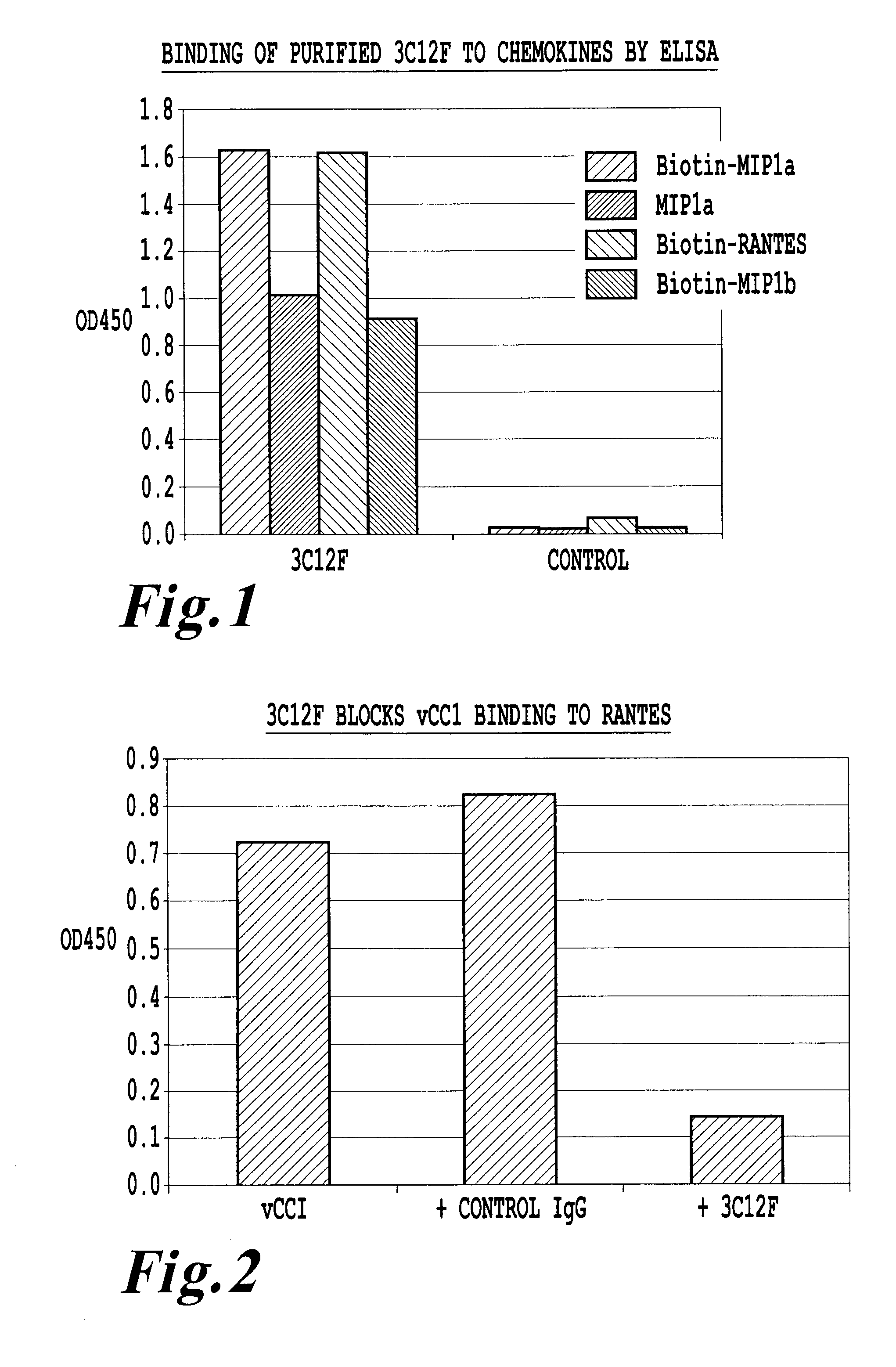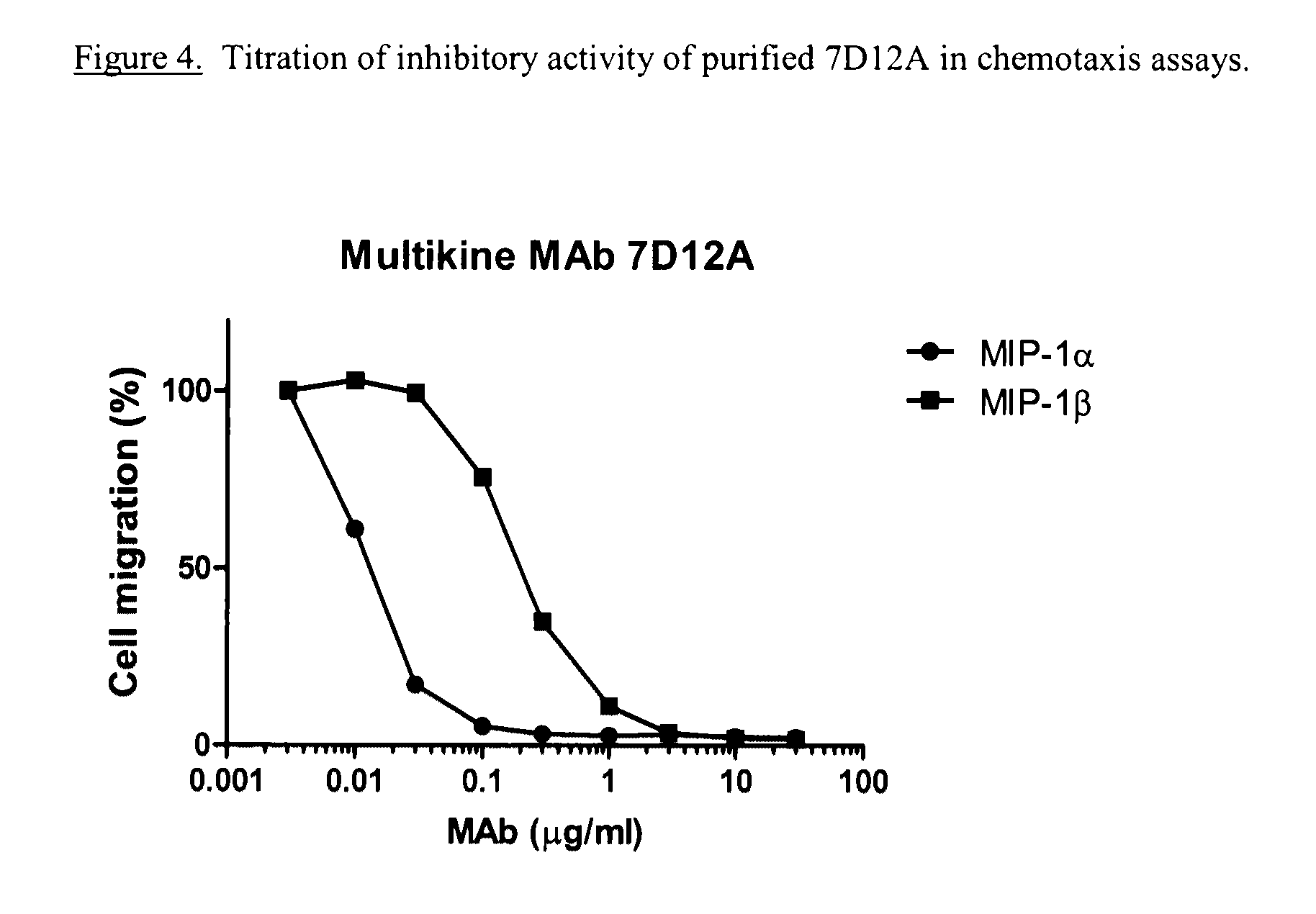Antikine antibodies that bind to multiple cc chemokines
a technology of chemokine and antikine antibodies, applied in the field of antikine antibodies, can solve the problems of lack of efficacy, complicated efforts, failure to achieve the clinic for treating autoimmune indications, etc., and achieve the effect of inhibiting chemotaxis
- Summary
- Abstract
- Description
- Claims
- Application Information
AI Technical Summary
Benefits of technology
Problems solved by technology
Method used
Image
Examples
example 1
Production of Hybridomas Producing Antikine Antibodies
[0244]Mice were immunized sequentially with three CC-chemokines, in random order, from the set that initially included MIP-1α, RANTES and MCP-1 (PeproTech). For hybridoma fusion 3, which produced MAb 3C12F, the mouse was initially immunized with MIP-1α, followed by boosts with RANTES, then MCP-1, then MCP-1 again. For hybridoma fusion 7, which produced MAbs 7D12A and 7D1G, the mouse was initially immunized with MIP-1α, followed by boosts with MCP-1, then RANTES, then a combination of MIP-1α and RANTES. For hybridoma fusion 18, which produced MAbs 18V4F and 18P7E, mice were immunized initially with MIP-1β, followed by boosts with MIP-1α, then RANTES, then another boost with RANTES.
[0245]For each immunization 10 μg protein was used, following standard immunization protocols, see Current Protocols in Immunology, Eds. J E Coligan, et al. (2006), section 2.1. The initial immunizations were done in Complete Freund's Adjuvant, followed ...
example 2
Identification of Antikine Antibodies
[0251]Antibodies in the hybridoma supernatant obtained in Example 1 were tested for their ability to recognize MIP-1α, RANTES, MCP-1 and MIP-1β by ELISA (similar to serum tests described above). ELISA results for initial hybridoma supernatants are shown in Table 2 below. Cells from fusion wells that showed reactivity of at least 4-fold over background with more than one chemokine were expanded into 24-well plates for further testing. Cells from wells that reacted with at least 3 chemokines were cloned by limiting dilution or by serial dilution at least two times. Clone plate supernatants were again tested by ELISA to identify individual clones that produced antibody reactive against multiple chemokines. Positive wells were confirmed to be clonal by visual inspection.
[0252]Alternatively, hybridomas grown as colonies in semi-solid media were analyzed after 16 days for growth and fluorescent chemokine binding using ClonePixFL (Genetix), and the best...
example 3
Characterization of Chemokine Binding Specificities of Antikine Antibodies
[0253]A more complete analysis of the chemokine binding specificities for the isolated antikine antibodies was performed using an MSD (Meso Scale Discovery) assay. This is very similar to the ELISA assays done during antibody screening, however it uses electrochemiluminescence detection of SULFO-TAG reagents. In this case, a selection of chemokines is coated at 1 μg / mL on an MSD 96-well multiarray plate (MA2400). Antikine antibodies are added either at 3 μg / mL (purified antibodies 3C12F, 7D12A, 7D1G, 18V4F) or as unquantitated hybridoma antibody-containing supernatant (18P7E) and are detected with a SULFO-TAG anti-murine antibody used at 1 μg / mL. Plates are read on an MSD sector imager 2400. Background levels shown as dotted lines in the Figures are based on binding to a non-reactive protein, bovine serum albumin (BSA).
PUM
| Property | Measurement | Unit |
|---|---|---|
| Tm | aaaaa | aaaaa |
| body weight | aaaaa | aaaaa |
| time | aaaaa | aaaaa |
Abstract
Description
Claims
Application Information
 Login to View More
Login to View More - R&D
- Intellectual Property
- Life Sciences
- Materials
- Tech Scout
- Unparalleled Data Quality
- Higher Quality Content
- 60% Fewer Hallucinations
Browse by: Latest US Patents, China's latest patents, Technical Efficacy Thesaurus, Application Domain, Technology Topic, Popular Technical Reports.
© 2025 PatSnap. All rights reserved.Legal|Privacy policy|Modern Slavery Act Transparency Statement|Sitemap|About US| Contact US: help@patsnap.com



